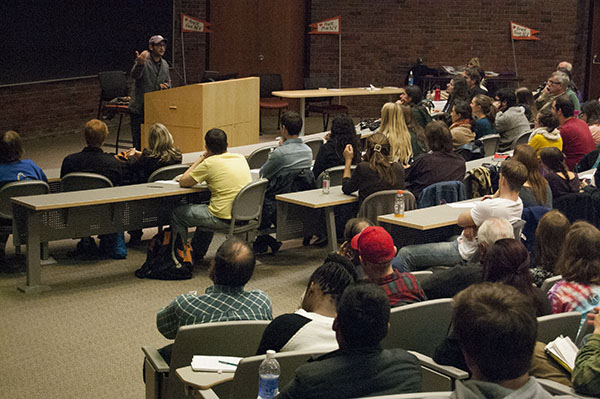

Homes lifted off their foundations as the remnants of human lives floated through the streets and a parking lot filled with piles and piles of what was once a community — this is the scene “Gasland” director Josh Fox recalled of Hurricane Sandy’s devastating descent into New York Harbor on Oct. 29, 2012.
Fox addressed nearly 500 people in the SUNY New Paltz Lecture Center (LC) 100 on the storm’s one-year anniversary Tuesday night. The crowded room included just as many students as it did residents from New Paltz and the surrounding area.
In Sandy’s wake, Gov. Andrew Cuomo pointed to climate change as contributing to the super storm’s intensity. “But I think part of learning from this is the recognition that climate change is a reality, extreme weather is a reality, it is a reality that we are vulnerable,” said Cuomo just days after the storm.
But for Fox, a banjo-wielding documentary filmmaker from the upper Delaware River basin in Pennsylvania, Cuomo “breaking the climate silence” isn’t enough.
“We can’t talk about climate change and also allow [hydraulic fracturing] to go on,” said Fox. “That’s shameful, contradictory speech.”
Place-cards reading “Thank you for keeping New York Frack Free!” lined the walls of the Lecture Center room, a common message at anti-hydrofracking rallies aimed at Cuomo, serving as a reminder of New York’s five-year long moratorium on the controversial natural gas extraction method.
“Natural gas is presented as the solution. It’s presented as the methadone treatment for our heroin-like addiction to coal and oil – but it’s just another drug,” Sociology Department Chair Brian Obach said. “It does nothing to cure us of our addiction.”
Obach said that having facts or science that shows hydrofracking is harmful to the environment and human health isn’t enough.
“Behind those facts, we need mobilized citizens, and that isn’t easy to achieve – that’s where Josh Fox comes in.”
In 2008 a gas company began leasing land around Fox’s home, the site of the Marcellus Shale – the country’s largest underground deposit of natural gas. It runs from West Virginia, through Ohio and Pennsylvania to New York. Two years later he released “Gasland.”
Fox has spent much of the last three years promoting his films and documenting the anti-hydrofracking movement across the country. Images in “Gasland” such as methane-tainted kitchen faucets spewing flaming water are now ubiquitous. In April 2013 he released “Gasland II.”
There was no consensus on hydrofracking among New Yorkers as late as 2012. According to the Siena College survey taken that year, 42 percent of state voters supported hydrofracking move forward in parts of upstate New York while only 36 percent were opposed.
Those numbers are now reversed.
A Siena poll released last month found 45 percent of New York voters are opposed to moving forward with hydrofracking in the state, compared to just 37 percent who support it.
Fox said a “strong grassroots movement” in New York is the reason a moratorium is still in place.
In New York, Cuomo is now at the center of an increasingly contentious debate about whether Albany should place a permanent ban on the practice. The Department of Health’s environmental review of hydrofracking drew 204,000 written comments from the public earlier this year.
There’s currently no timeline for when that review will be completed, but Cuomo said he’ll make a final decision by the 2014 elections. Some municipalities, like New Paltz, have passed their own bans.
Fourth-year political science major Will Raphaelson, who attended the talk, said the moratorium was “great,” but telling of Cuomo’s White House aspirations.
“It would seem that his lack of promises regarding fracking are more or less an effort to keep the blood off of his hands long enough to get to the White House,” Raphaelson said.
However, Fox asked the audience to look beyond implementing a ban and towards developing community-driven solutions to the energy crisis.
“We need to develop renewable energies in a way that’s rooted in the sometimes messy process of citizen engagement, a democratic process,” Fox said
According to Fox, Occupy Sandy, a relief network made up of Occupy Wall Street protesters which worked with low-income communities affected by the storm, is a model for such a process.
The group estimates it provided 300,000 meals, remediated over 1000 homes and over a million dollars’ worth of donated supplies. Today, some 200 survivors are still without homes according to the Daily News.
In the spring, Fox said he’ll be touring again, this time without a new film. The focus then will be hosting workshops to link communities with resources to build their own renewable energy infrastructure.
“I’d like to come back and do one here,” said Fox.
*Additional reporting by Assistant Copy Editor Hannah Nesich
